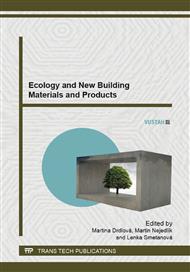p.326
p.330
p.334
p.338
p.342
p.346
p.352
p.356
p.360
Influence of Moisture and Temperature of Calcium Silicate Bricks on Results of Measurements with Rebound Hammer
Abstract:
Testing with rebound hammers is influenced by various factors, like composition and components of tested material, treatment of tested surface, moisture content of tested material, temperature of material and environment. Influence of these factors on measurement results during testing concrete is described in technical literature and standards. Calcium silicate body can be characterized as non-cement based fine grained concrete, however, with considerably higher water absorbing capacity compared to standard concrete: ca 12-14% (fine aggregate bonded by hydration products of lime). To use rebound hammers for testing calcium silicate bricks, influence of selected factors on measurement results was tested. It was proved, that content of moisture and temperature of calcium silicate brick has influence on results of measurements with rebound hammer, and therefore it is necessary to take into account these influences.
Info:
Periodical:
Pages:
352-355
Citation:
Online since:
August 2014
Authors:
Keywords:
Price:
Сopyright:
© 2014 Trans Tech Publications Ltd. All Rights Reserved
Share:
Citation:


